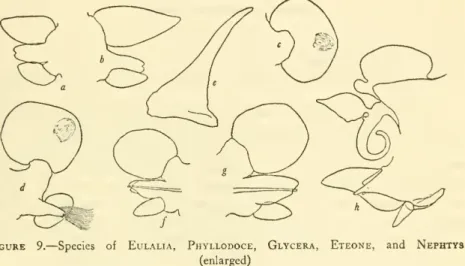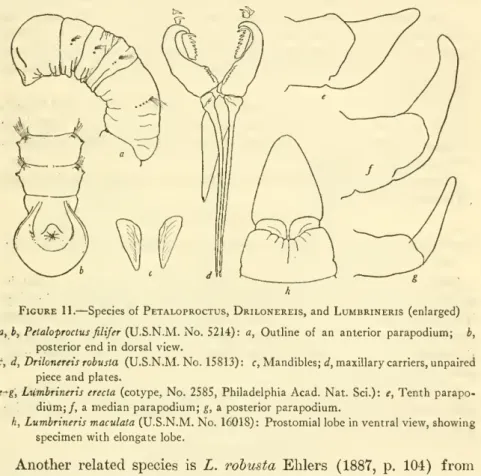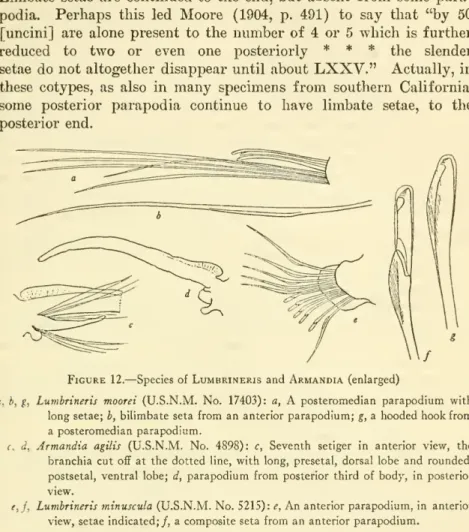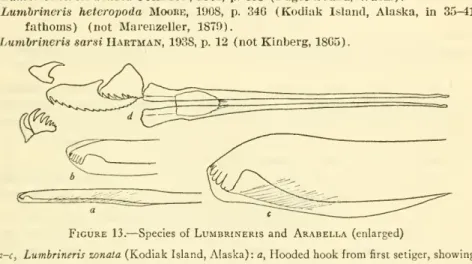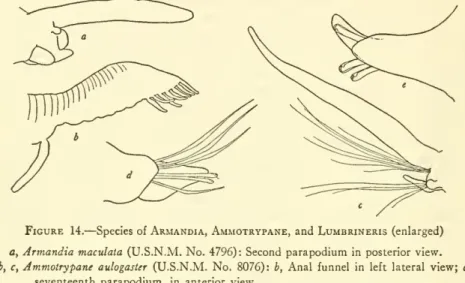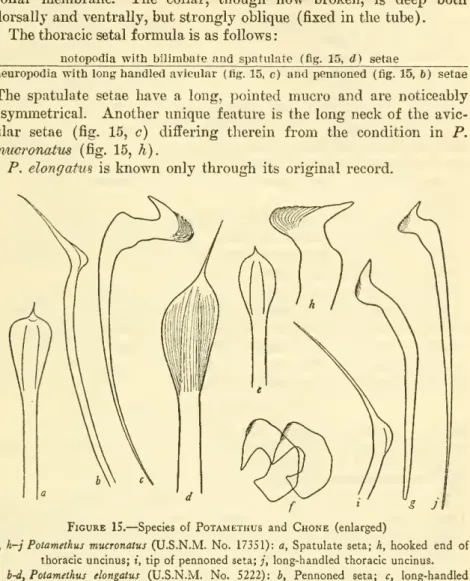Both have similar papillations across the ventrum between the base of the ventral cirri and the body wall. Paired prostomial antennae about as large, inserted on dorsal base of first setae. The median antenna is placed on a stout ceratophore with auricular paired ctenidia at its base; side cirrus extends distally about as far as the setae of the first segment.
Paired antennae are small, inconspicuous and inserted near the inner base of the first setiger. Paired antennae are placed on the first set of tigers, with the style being approximately one-third as long as that of the center style.
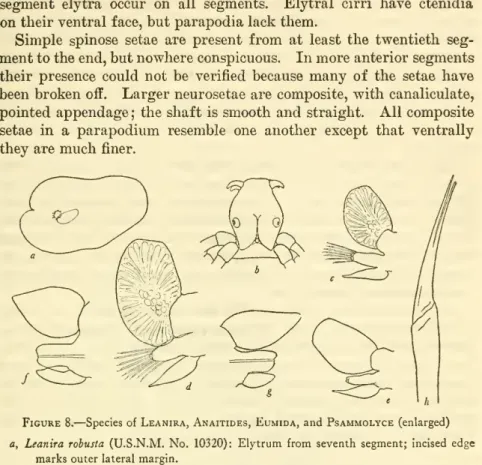
IDENTITY OF SOME MARINE ANNELIDS — HARTMAN 111
Despite many attempts to encourage the emergence of the rilechka to life, there was no success. The median prostomial antenna is inserted a short distance in front of the large dark pair of eyes. Dorsal cirri thin, foliaceous, longer than wide, but increasing posteriorly; these parts are shown in Figur e 8.
IDENTITY OF SOME MARINE ANNELIDS
HARTMAN 113 Genus ETEONE Savigny
The most striking feature is the greatly elongated, slightly depressed prostomial lobe (Fig. 10,a); eyes are missing. Here, however, the distal ends of the hooded hooks are clearly bidentate; the maxillary apparatus is also different. Compound bristles are continued by at least 26 segments, in the last of which there are at least three limbs, two compound hooks, and three simple hooded hooks.
In this specimen the third maxillary plate on both the right and left sides is clearly bifid (fig. 10, h); the tweezers are obviously fake. The latter are simply low, rounded, cushion-like or compressed; The postsetal lobes are more or less acutely pointed, but their length is not greater than their width (fig. 10, Jc). The first 16 segments in this part are equipped with limbate setae and compound hooks (fig. .. 12, e); in the next segments there are, in addition to superior and.
The distribution of the setae is as first described; figure 12, a, shows the greatly elongated limb region of the pointed part in anterior segments; cap hooks simple, with minutely denticulated distal ones. It is difficult to make a close comparison of these species with long setae due to the lack of information on several important points. The mandibles are white, calcareous, but now considerably hollowed and soft; the two parts are long, almost equal to the length of the entire maxillary apparatus; the base is incised for a short distance; the distal end is.
In the original description, simple hooks are shown in the second parapodium, accompanied by limbate setae.
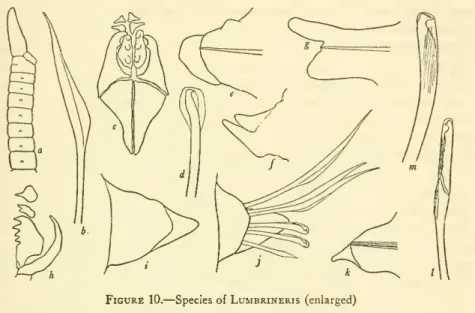
IDENTITY OF SOME MARINE ANNELIDS — ^HARTMAN 119 determined the plates are symmetrical on the two sides." This
IDENTITY OF SOME MARINE ANNELIDS — ^HARTMAN 119determined that the plates are symmetrical on both sides." This. , h) Forceps are falcate; maxilla II -has four teeth on each side; maxilla III has two teeth on one side;
Parapodia from first setiger have both limbate hooks and simple hooks, postsetal lobe now long, triangular; second parapodium shown in figure 14, d. The types of this species are not deposited in the National Collections; Copies are in the Academy of Natural Sciences of Philadelphia (No. 2585). There are three large, robust specimens which agree closely with many specimens collected by the author in the intertidal areas of southern California.
The prostomy has, as originally, a longitudinal groove ventrally, but this is weak in one individual.
IDENTITY OF SOME MARINE ANNELIDS — ^HARTMAN 121
Das Prostomium wurde als deutlich spitz, groß, länger als breit, genauso lang oder länger als die ersten drei Segmente beschrieben. 34; Bei den Vorderrudern ist die Hinterlippe von vorne nach hinten zusammengedrückt, von oben betrachtet schmal, an der Spitze leicht geschwollen, die Vorderlippe ist kurz und steht fast gar nicht hervor [Abb. 10, e, basierend auf einem Exemplar in USN.M.] Allmählich wird die hintere Lippe dicker [in der antero-posterioren Achse], aber etwas kürzer, und während sich auch die vordere Lippe entwickelt, wird der Längenunterschied zwischen den beiden kleiner; Der erste übertrifft jedoch diese Statistiken [Abb.
10,g] said that it was a relative finger former, after a hint more focused fort, half of the long, vom Ursprunge des Ruders bis zum Vorderrand der nur wepigvorspringenden Vorderlippegemessen, ausmacht. specific name heteropoda. Furthermore, the first 35 segments would only have pointed setae, of which there were initially 13 in a parapodium, decreasing to 8 in the thirty-fifth. From the thirty-sixth segment, cap hooks were present, accompanied by pointed setae, the latter continuing in decreasing numbers until the end (at least through 200 segments above) apparently due to a misinterpretation of Marenzeller's description, based on collections from the Red Sea, Zanzibar and the Kenyan colony, but none from Japan or California.
IDENTITY OF SOIME MARINE ANNELIDS — ^HARTMAN 123 body segments have parapodia with prominent postsetal lobes which
National collections contain specimens from Behm Channel, Alaska (Albatross Station), including depths from 14 to 256 fathoms. The prostomium is subglobose, with four eyespots in a transverse row; the parapodia are furnished only with pointed limbate appendages, i.e. Arabella. There is only one fragment, with much of the jaw apparatus missing and most of the appendages broken off flush with the body wall.
The prostomium is elongated, depressed, triangular, without eyespots or other color markings; it lacks a median sulcus, but has a depression in the middle on both the dorsal and ventral sides. In the posterior segments the limbs are pointed distally, curved in the winged region; the upper and lower are smooth, but three or four in the middle part of the fascicle are serrated, with several rows of spines in the thickest area. iridescens is characterized by a depressed, triangular prostomium without eyespots; upper jaw. There is only one incomplete fragment that was then dried. received; it lacks the head and anterior end, including proboscideal parts.
Arabella Grube and Drilonereis Claparede- and differ from the first eyespots in being scratched and having strong acicular nodes and from the second in possessing well-developed jaw parts in which the pincers are strongly falcate, with basal teeth; the other paired parts are also denticulate (fig. Heavy acicular spines are first seen emerging from the anteroventral part of the eighteenth setiger; they become heavier and. There is only an anterior fragment with proboscis retracted and prostomium retracted into the cavity anterior buccal.
IDENTITY OF SOME MARINE ANNELIDS — ^HARTMAN 127Dorsal branchiae arise from first setiger, but there is one pair.
IDENTITY OF SOME MARINE ANNELIDS — ^HARTMAN 127 Dorsal branchiae arise from the first setiger, but there is a pair of
The lateral tentacles first develop from a point dorsal to the notopodial ridge, but in the median and posterior segments the point of insertion gradually moves upwards to come almost midway between the notopodium and the midline. Branches present from second to fifth last segment, numbering 40 or more pairs; they are simple, ciriform, extending distally far beyond the tips of the attachment (Fig. 14, c). The anal end has a long funnel-shaped lobe, open ventrally, with a row of about seven pairs of filaments at the end and a simple or slightly toothed margin at its end.
Branches are present from the second segment; they are long, ciriform, present on all other segments to the end; on their back, near the base, they have a thin, leafy edge (Fig. 12, d). On the first segment, the upper presetal lobe (dorsal cirrus) is large and long, similar to the branchia, except of smaller size (it is about two-thirds as large); this gi-adually decreases in size posteriorly, so that in the last third of the body it is greatly reduced, papillary (Fig. 12, d). Caudal funnel long, compressed cylindrical, closed ventrally along a pair of longitudinal ridges, with about 14 filiform cirrus at its distal end and a much longer, thicker ventral cirrus.
Armandiaagilis differs from other species of the genus by its high number, in the structures of the presetal and postsetal lobes. Branches are present from the second, perhaps almost to the end or at least to the third to last segment; the posterior segments are now macerated, imperfect. Eyes cannot now be distinguished, but Webster (1884) described three, in a transverse series, near the posterior margin of the lobe.
130 PROCEEDINGS OF THE NATIONAL MUSEUM
IDENTITY OF SOME MARINE ANNELIDS HARTMAN 131 Family MALDANIDAE
The head is bent at an angle (almost right) to the body, and extends dorsally with a sharp, narrow transverse ridge, about one-fourth the distance from the first setiger to the anterior end. The rear edge of the first is provided with a large, full collar, which fits more or less tightly to the body. A similar collar from the anterior border of the third setiger extends forward around the posterior end of the second setiger, but this collar is less than half as high as the second and is longest on the ventral side; it is entire, with wide, shallow, dorsal fissures and a short, dorsal flap.
The dorsal side of the thorax, and to a lesser extent the ventral side, including the abdomen, is more or less heavily spotted with deep reddish-brown spots, and heavier, larger spots occur regularly on the parapodiarygen between thenotopodium and neuropodium. The collar membrane consists of conspicuous rounded lobes that are not sharply separated from the lateral lobes; the ventral lobes are longer, triangular, but continuous with the lateral lobes.
IDENTITY OF SOME MARINE ANNELIDS — HARTMAN 133 Genus MEGALOMMA Johansson
The tentacular filaments are much elongated, but of unequal lengths and free for their entire length;. It is long, slender, without eyes or stylodes; they are free for their entire length.
IDENTITY OF SOME MARINE ANNELIDS — HARTMAN 135
Some radioles are still united by a palmate membrane that extends well over half the length of the radioles. It is furnished with long uncini handles (fig. 15, g)^ and spade-shaped attachments (fig. 15, e) in addition to the upper pointed limbate. This species was originally designated as Jasminiera because radioles were thought to lack a palmate membrane; but as this is supposed to have been present, it is transferred to Ghone.
784." This is typical Ghone Malmgren, with an entire straight collar, which is rather high, slightly flared, with a notch dorsally. The thorax includes eight setae, provided dorsally with bilimbate setae, and spatulate setae and ventrally with long handled hooks.
LITERATURE CITED
Crossland in Colon, in the region of Panama and the Galapagos Islands during the expedition of S.
IDENTITY OF SOME MARINE ANNELIDS — HARTMAN 139
